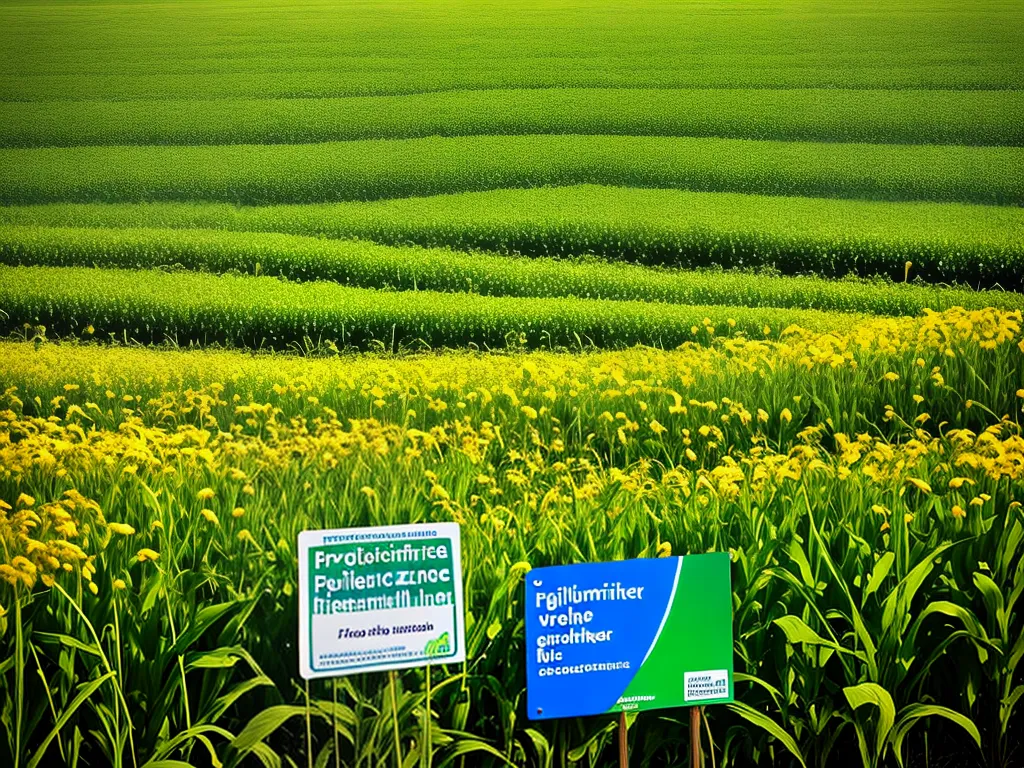Olá, queridos leitores! Hoje vamos falar sobre um assunto muito importante e que tem impacto direto em nossas vidas: a agricultura. Você já parou para pensar como os alimentos que chegam à sua mesa são produzidos? Será que o uso de pesticidas é realmente necessário para garantir uma boa colheita? E se houvesse uma alternativa mais sustentável e eficiente? É justamente sobre isso que vamos discutir neste artigo: a revolução na agricultura por meio dos biofertilizantes. Será que eles podem substituir os pesticidas? Qual é a diferença entre eles? Vamos descobrir juntos!

Resumo de “Revolutionizing Agriculture: Biofertilizers vs Pesticides”:
- Agriculture has traditionally relied on pesticides to control pests and increase crop yields.
- However, pesticides can have negative effects on the environment and human health.
- Biofertilizers, on the other hand, are a natural alternative that can improve soil health and plant growth without harmful side effects.
- Biofertilizers contain beneficial microorganisms that can fix nitrogen, solubilize phosphorus, and produce growth-promoting hormones.
- Biofertilizers also have the potential to increase crop resilience to environmental stressors such as drought and disease.
- While biofertilizers may not provide the same immediate pest control as pesticides, they can contribute to a more sustainable and long-term approach to agriculture.
- As consumers become more aware of the environmental and health impacts of pesticides, there is a growing demand for biofertilizers and other natural alternatives.

The Growing Need for Sustainable Agriculture
As a society, we depend on agriculture to provide us with the food we need to survive. However, traditional farming practices have taken a toll on our environment and our health. The use of chemical-based fertilizers and pesticides has led to soil degradation, water contamination, and the loss of biodiversity. It’s time to find a more sustainable approach to agriculture.
Biofertilizers: The Key to Healthier and More Productive Soils
Biofertilizers are natural fertilizers that contain living microorganisms that help improve soil health and fertility. Unlike chemical-based fertilizers, biofertilizers don’t harm the environment or human health. They also promote the growth of beneficial microorganisms in the soil, which can help plants absorb nutrients more effectively.
Pesticides: Are They Doing More Harm Than Good?
Pesticides are chemicals used to kill pests that damage crops. However, they can also harm beneficial insects, birds, and other wildlife. Pesticides can also contaminate water sources and harm human health. In addition, pests can develop resistance to pesticides over time, making them less effective.
Understanding the Risks of Chemical-based Agriculture
Chemical-based agriculture has been the norm for decades, but it comes with significant risks. The use of synthetic fertilizers and pesticides can lead to soil degradation, water contamination, and the loss of biodiversity. These chemicals can also harm human health by causing respiratory problems, skin irritation, and even cancer.
How Biofertilizers are Revolutionizing Farming Practices
Biofertilizers are changing the way we think about agriculture. By promoting healthy soil and beneficial microorganisms, biofertilizers can improve crop yields and reduce the need for chemical-based fertilizers and pesticides. They also help reduce greenhouse gas emissions and promote sustainable farming practices.
Increasing Crop Yields with Natural Solutions
Biofertilizers can help increase crop yields by improving soil health and promoting nutrient absorption. They can also help plants resist diseases and pests naturally. By using natural solutions instead of chemical-based ones, farmers can produce healthier and more abundant crops while protecting the environment.
A Greener Future for Agriculture: Embracing Biofertilizers
As we look towards a more sustainable future, biofertilizers offer a promising solution for agriculture. By embracing natural solutions like biofertilizers, we can reduce our dependence on chemical-based fertilizers and pesticides, protect the environment, and promote healthier crops. It’s time to revolutionize agriculture and embrace a greener future.

| Product | Definition | Advantages |
|---|---|---|
| Biofertilizers | Microorganisms that help improve soil fertility and plant growth. |
|
| Pesticides | Chemical substances used to control pests and diseases in crops. |
|
| Biofertilizers | Can be used in organic farming and sustainable agriculture. |
|
| Pesticides | Can have negative effects on human health and the environment. |
|
| Biofertilizers | Can improve soil biodiversity and promote natural pest control. |
|
Biofertilizers and pesticides are two products that can revolutionize agriculture. Biofertilizers are microorganisms that help improve soil fertility and plant growth, while pesticides are chemical substances used to control pests and diseases in crops.
Biofertilizers have several advantages over pesticides. They are environmentally friendly, cost-effective, reduce soil erosion, improve soil structure, and enhance plant nutrition. They can also be used in organic farming and sustainable agriculture, as they improve soil health, enhance crop quality and yield, reduce dependence on chemical fertilizers, and can be used in combination with other agricultural practices. Biofertilizers can also improve soil biodiversity and promote natural pest control by stimulating the growth of beneficial microorganisms, attracting natural predators of pests, reducing the need for chemical pesticides, and improving soil fertility in the long-term.
On the other hand, pesticides can have negative effects on human health and the environment. They can lead to pesticide resistance in pests, harm beneficial insects and wildlife, contaminate soil and water, and cause health problems for farmers and consumers. However, pesticides are effective in controlling pests and diseases, increasing crop yield, reducing crop loss, and can be used in large-scale farming.
In conclusion, while both biofertilizers and pesticides have their advantages and disadvantages, biofertilizers are a more sustainable and environmentally friendly option for agriculture. By using biofertilizers, farmers can improve soil health, enhance crop quality and yield, reduce dependence on chemical fertilizers, and promote natural pest control.

1. O que são biofertilizantes e como eles funcionam?
Resposta: Biofertilizantes são produtos naturais que contêm microrganismos benéficos para as plantas. Eles ajudam a melhorar a absorção de nutrientes pelas raízes, aumentando a produtividade e a resistência das plantas a doenças e pragas.
❤️Seus amigos estão gostando:
2. Como os biofertilizantes podem ajudar a diminuir o uso de agrotóxicos?
Resposta: Ao fortalecer as plantas, os biofertilizantes ajudam a reduzir a incidência de doenças e pragas, o que pode diminuir a necessidade de aplicação de agrotóxicos. Além disso, os microrganismos presentes nos biofertilizantes podem ajudar a controlar naturalmente algumas pragas e doenças.
3. Quais são os principais tipos de biofertilizantes?
Resposta: Os principais tipos de biofertilizantes são os compostos orgânicos, os bioestimulantes vegetais, os inoculantes microbianos e os extratos vegetais.
4. Como produzir biofertilizantes em casa?
Resposta: É possível produzir biofertilizantes em casa utilizando restos de alimentos, como cascas de frutas e legumes, que podem ser transformados em compostagem. Também é possível fazer extratos vegetais e fermentações caseiras com ingredientes como urina, açúcar mascavo e leite.
5. Os biofertilizantes são seguros para o meio ambiente?
Resposta: Sim, os biofertilizantes são seguros para o meio ambiente, pois são produtos naturais e não contêm substâncias tóxicas como os agrotóxicos.
6. Os biofertilizantes podem ser utilizados em cultivos orgânicos?
Resposta: Sim, os biofertilizantes são permitidos em cultivos orgânicos, pois são produtos naturais e não contêm substâncias sintéticas.
7. Como os biofertilizantes podem melhorar a qualidade dos alimentos?
Resposta: Ao fortalecer as plantas e aumentar a absorção de nutrientes, os biofertilizantes podem melhorar a qualidade dos alimentos produzidos, tornando-os mais nutritivos e saborosos.
8. Os biofertilizantes podem ser utilizados em todos os tipos de plantas?
Resposta: Sim, os biofertilizantes podem ser utilizados em todos os tipos de plantas, desde hortaliças até árvores frutíferas.
9. Como os biofertilizantes podem ajudar a reduzir os custos na produção agrícola?
Resposta: Ao diminuir a necessidade de aplicação de agrotóxicos e aumentar a produtividade das plantas, os biofertilizantes podem ajudar a reduzir os custos na produção agrícola.
10. Os biofertilizantes podem substituir completamente os agrotóxicos?
Resposta: Não, os biofertilizantes não podem substituir completamente os agrotóxicos, mas podem ser utilizados em conjunto com eles para reduzir a quantidade necessária de aplicação.
11. Como os biofertilizantes podem contribuir para uma agricultura mais sustentável?
Resposta: Ao reduzir a necessidade de aplicação de agrotóxicos e aumentar a produtividade das plantas, os biofertilizantes podem contribuir para uma agricultura mais sustentável, que respeita o meio ambiente e a saúde humana.
12. Como os biofertilizantes podem ajudar na recuperação de solos degradados?
Resposta: Os biofertilizantes podem ajudar na recuperação de solos degradados ao promover a atividade microbiana e aumentar a fertilidade do solo.
13. Como os biofertilizantes podem ser aplicados nas plantas?
Resposta: Os biofertilizantes podem ser aplicados diretamente no solo, na forma líquida ou sólida, ou pulverizados nas folhas das plantas.
14. Os biofertilizantes têm prazo de validade?
Resposta: Sim, os biofertilizantes têm prazo de validade e devem ser armazenados em local fresco e seco para manter sua eficácia.
15. Os biofertilizantes são uma alternativa viável aos agrotóxicos?
Resposta: Sim, os biofertilizantes são uma alternativa viável aos agrotóxicos, pois são produtos naturais e não causam danos ao meio ambiente e à saúde humana. Além disso, podem ajudar a aumentar a produtividade das plantas e reduzir os custos na produção agrícola.
- Chá de Romã: A Bebida que Protege o Seu Coração - abril 7, 2024
- A Poderosa Aloe Vera: Mais do que Apenas Queimaduras Solares - abril 5, 2024
- Crie Seu Próprio Remédio Caseiro com Ervas do Jardim - abril 4, 2024